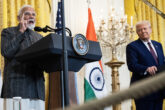November 26, 2018
Ten Years After Mumbai, the Group Responsible Is Deadlier Than Ever
Ten years ago today, ten gunmen from Lashkar-e-Taiba launched a complex attack that lasted over 60 hours against India’s commercial capital, Mumbai. They targeted two luxury hotels, one of the country’s busiest railway stations, a café popular with foreign tourists, and a Jewish community center. The “26/11 attacks,” as they are known in India, left 166 people dead, and put Lashkar-e-Taiba on the global map. By the time of the attacks, it was already one of the most powerful terrorist groups in South Asia, and generally considered to be Pakistan’s most reliable proxy against India.
I devoted several years of my life to researching this militant group’s evolution, and exploring the calculus behind Mumbai for my first book, Storming the World Stage: The Story of Lashkar-e-Taiba. The attacks derailed a fragile peace process between India and Pakistan, created fears that another attack of similar scale and lethality in India would trigger war between the two nuclear-armed powers, and ushered in a trend of active shooter sieges by other jihadist groups. The most notable legacy of the attacks, however, may be that the group has actually increased its presence and influence in Pakistan despite the widespread knowledge that it was responsible for killing 166 people, including six Americans. Bluntly speaking: Lashkar-e-Taiba got away with it. That fact says a lot about the group and about Pakistan.
Read the full article in War on the Rocks.
More from CNAS
-
Indo-Pacific Security / Energy, Economics & Security
Trump Unfriends Modi's India: Trump Frothing, India CalmFrom tariffs to tantrums-Trump's latest anti-India tirade stirs global concern. As Washington watches in disbelief, Shiv Aroor discusses what this "break-up" means for India-U...
By Daniel Silverberg
-
Will New Delhi-Beijing Move Beyond Friction Points? | Ex-White Official On India-China Reset
Prime Minister Narendra Modi on Friday said that India and China, as two major economies, must work together to bring stability to the global economic order. NDTV's Gaurie Dwi...
By Lisa Curtis
-
SCO Preview: Modi Heads to China Amid U.S. Tariff Shock
Indian Prime Minister Narendra Modi left Northeast Asia this week, embarking on a two-stop trip that includes Japan and then China, where he will participate in the Shanghai C...
By Derek Grossman
-
Trump’s Lesser-Known Conflicts
President Trump has been focusing on some of the lesser-known conflicts in the world as peace remains elusive for Ukraine and Gaza. Lisa Curtis, senior fellow and program dire...
By Lisa Curtis




